This article was co-authored by wikiHow Staff. Our trained team of editors and researchers validate articles for accuracy and comprehensiveness. wikiHow's Content Management Team carefully monitors the work from our editorial staff to ensure that each article is backed by trusted research and meets our high quality standards.
There are 10 references cited in this article, which can be found at the bottom of the page.
This article has been viewed 24,620 times.
Learn more...
Parkour, a sport and philosophy with efficient movement of the human body at its core, offers a wide variety of fun jumps. Vaults are one particular subset of those jumps that you will be able to use to get yourself over obstacles like railings, ledges, and other types of barriers. There are endless variations of parkour vaults, but if you master the basic safety vault (also known as a step vault) and speed vault, then you will be able to get yourself safely and quickly over many different types of obstacles. Then, you can move on to other more complicated vaults, like the reverse vault!
Steps
Doing a Safety Vault
-
1Find a basic obstacle at about waist height. Choose an obstacle like a handrail, a ledge, or any other obstacle that you will be able to comfortably place a foot and a hand on to lift yourself over. Make sure there is room on the other side for you to land while you practice the safety vault.[1]
- The safety vault is one of the first vaults you need to learn in parkour. It is a basic vault that you can perform with little or no momentum to get yourself over regular obstacles.
- The safety vault is a good move to use when you are not confident enough to use another type of vault to get over something. As the name implies, it will help you get safely to the other side.
-
2Place a hand and foot that are opposite each other on top of the obstacle. Stand in front of the obstacle. Place your left hand and right foot on the object, or right hand and left foot on the object.[2]
- The goal is to create enough balance between your hand and foot to lift yourself up and over the obstacle. Practice placing your hand and foot on the obstacle until you are comfortable with the motion and feel balanced enough to move on to vaulting yourself over the obstacle.
Advertisement -
3Jump slightly and bring your other foot through the middle. Support your weight with the hand and foot that are on the obstacle. Jump enough so that you are able to swing your other foot through the middle to the other side of the obstacle.[3]
- You can use 2 hands to help yourself balance if you feel that you need a little bit more stability.
-
4Land on the foot you brought through the middle followed by the other foot. Let the momentum of swinging your foot through the middle carry you over the obstacle. Release your hand and follow with your other foot as you land on the foot you swung through.[4]
- You can start off practicing this move very slowly, as you don’t have to run up to the obstacle to perform the vault. Once you get comfortable, you can practice speeding it up gradually.
Tip: Once you master the basic safety vault, you can add variations. Try doing it from further away, running up to the obstacle, or jumping up and away from the obstacle rather than just vaulting over it.
Performing a Speed Vault
-
1Run towards an obstacle that you feel comfortable jumping over. Pick a medium-height obstacle (at about your waist height) like a railing, concrete ledge, or other type of barrier. Run towards it to build up momentum for the vault.
- The speed vault is a parkour vault that is used for getting over low- to medium-height obstacles quickly and smoothly while running. You can use it while approaching obstacles, or from an angle (called a lazy vault).
Tip: It will help to learn the safety vault before you start practicing the speed vault. You can turn the speed vault into a safety vault midway through by placing your dominant leg on the obstacle as you pass over and swinging your non-dominant leg through.
-
2Launch off the ground with your non-dominant foot as you reach the obstacle. Jump off of one foot when you are close enough to comfortably reach the obstacle. Push yourself forward, head-first, to start moving up and over the obstacle.
- For example, if you are right-footed, then jump off of your left foot.
-
3Kick your dominant leg upwards to help your body get over the obstacle. Bend your other knee and swing the leg up and out to the side so you can clear the obstacle. Bring the leg you launched off of up and to the same side so you can get your whole body over the barrier.
- For instance, if you launched off of your left foot, then bend your right knee and swing your right leg up and out to the right hand side, followed by the leg you launched off of (which will be almost straight since you jumped off it).
-
4Place your non-dominant hand on the obstacle as you lift off the ground. Don’t place your hand on the obstacle before both your feet are off the ground. Use your hand to just brush the obstacle enough to help carry you forward over it.[5]
- For example, if you jumped off your left leg, then place your left hand on the obstacle as you vault over.
- You just want your hand to act as a stabilizer as your momentum carries you over the barrier. Don’t put your whole weight on it or use it to push yourself over.
-
5Let your momentum carry you forward over the obstacle. Swing the leg that you jumped off of over the barrier first, followed by the other leg. Your upper body will pass over the barrier just before your legs do. Try to fly over the obstacle as straight as possible so you won’t land at an angle.
- If you jumped off your left foot, then at this point your left leg will be coming over the obstacle almost perpendicular to it with your foot facing towards the right. Your left hand will be just barely touching the object to keep you balanced, and your right leg will be above your left leg with the foot facing backwards.
- If you find that you need more support to stay balanced, you can tap the foot that’s on the outside against the barrier for more stability as you pass over the obstacle. Once you’re comfortable doing this, you can keep practicing until you’re able to clear the barrier without touching your foot to it.
-
6Drop the foot you launched off of straight down as you pass over. Bring your non-dominant leg back down, with your toes facing straight, as soon as you clear the barrier. The goal to land in the same direction you jumped.
- If you are bringing down your left foot first, then it will naturally pull your body to the left and your right leg will follow suit so you can land straight.
-
7Land on the foot and continue in a straight run out of the vault. Touch the ground with the foot you jumped off of first. Immediately follow it by landing the other foot in front of it and break into a run to keep your momentum going.
- If you jumped off of your left foot, then your left foot will hit the ground first, followed by your right foot in front of it, and you can proceed into a run.
Trying a Reverse Vault
-
1Run towards an obstacle at a controlled speed. Pick an obstacle that you can comfortably get over to practice on. Approach it by running at a steady, controlled speed. The more controlled your approach is, the more controlled your spin will be.[6]
- If you run too fast, you might end up over rotating and have a poor landing.
- The reverse vault is also known as the 360 vault or barrel vault.
Tip: Pick an obstacle with a flat surface to practice on. It will be much easier to pivot yourself over it because your hand can rest on the surface more stably.
-
2Put the hand that's on the opposite side of the direction you want to spin on the obstacle. For example, place your left hand on top of the obstacle if you want to spin your body to the right. Put your right hand on it if you want to spin to the left.[7]
- You might want to practice with your strongest hand first until you get the hang of it, then you can practice doing the vault in both directions. Your strongest hand is usually your dominant hand.
-
3Jump forward with both feet simultaneously and tuck your legs up. Plant your feet on the ground at the same time that you put your hand on the obstacle. Put your weight on your hand and jump forward, bringing both knees up towards your chest.[8]
- All of this needs to happen in a split second, so practice on an easy obstacle and at a slow pace until you get the movements down.
-
4Place your other hand down on the obstacle and shift your weight to it. Put down the hand on the side of the body that you are spinning towards. Shift your weight off the other hand and onto this hand to help you start spinning in that direction.
-
5Use your hand as a pivot and spin your body towards that side. Twist your body and swing your legs out and over the obstacle in the direction of the hand you are pivoting on. Let go with the first hand you put down.[9]
- For example, if you are pivoting on your right hand, then twist your torso and swing your legs out and behind you to the right to spin over the object.
- Looking over your shoulder in the opposite direction from which you are spinning will help your body naturally spin. You’ll also be able to see the ground sooner before you land.
-
6Rotate 360 degrees in the air over the obstacle and land on both feet. Let your momentum spin you all the way around as you are flying over the obstacle. Bring your legs back down towards the ground and look straight ahead as you reach the other side of the obstacle. Then, land on both feet and continue running.[10]
- You will have to practice to find the right momentum that lets you spin perfectly 360 degrees. Once you do, you can also use this trick to slow down your momentum when you are doing parkour runs.
Community Q&A
-
QuestionCan. I practise vault over a sofa
 Gavin DonnellyCommunity AnswerYes, you definitely can, as long as the sofa is sturdy enough that it won't flip over or something when you put your weight on it.
Gavin DonnellyCommunity AnswerYes, you definitely can, as long as the sofa is sturdy enough that it won't flip over or something when you put your weight on it. -
QuestionHow do you condition yourself for vaults?
 Evan LeopardCommunity AnswerRunning, jogging, and walking can help increase endurance. You can also practice jumping and landing.
Evan LeopardCommunity AnswerRunning, jogging, and walking can help increase endurance. You can also practice jumping and landing.
Warnings
- Reverse vaulting can be very disorienting, so don’t try it over any obstacles with a drop on the other side.⧼thumbs_response⧽
- Be careful when you are practicing parkour vaults. Make sure you have a clear landing space and pick obstacles you are comfortable with when you are learning to avoid injuring yourself.⧼thumbs_response⧽
References
- ↑ https://www.youtube.com/watch?v=OZFnbIOmmIY&feature=youtu.be&t=30
- ↑ https://www.youtube.com/watch?v=OZFnbIOmmIY&feature=youtu.be&t=73
- ↑ https://www.youtube.com/watch?v=OZFnbIOmmIY&feature=youtu.be&t=80
- ↑ https://www.youtube.com/watch?v=OZFnbIOmmIY&feature=youtu.be&t=83
- ↑ https://parkour.fandom.com/wiki/Speed_Vault
- ↑ https://www.youtube.com/watch?v=cTlIeAOQkqc&feature=youtu.be&t=303
- ↑ https://www.youtube.com/watch?v=cTlIeAOQkqc&feature=youtu.be&t=305
- ↑ https://www.youtube.com/watch?v=cTlIeAOQkqc&feature=youtu.be&t=306
- ↑ https://www.youtube.com/watch?v=cTlIeAOQkqc&feature=youtu.be&t=307

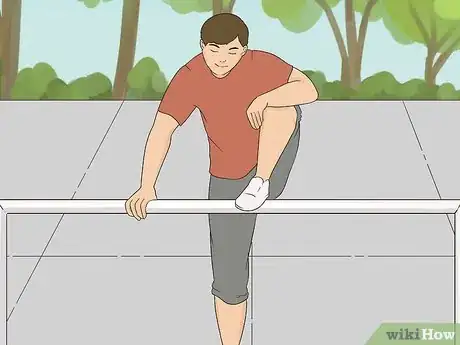








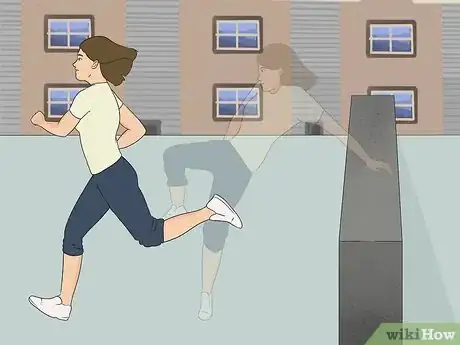
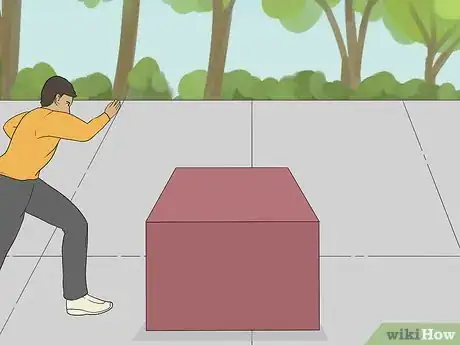

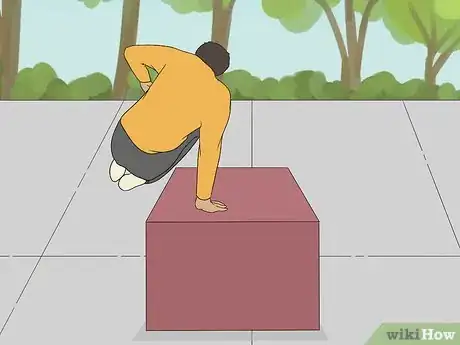
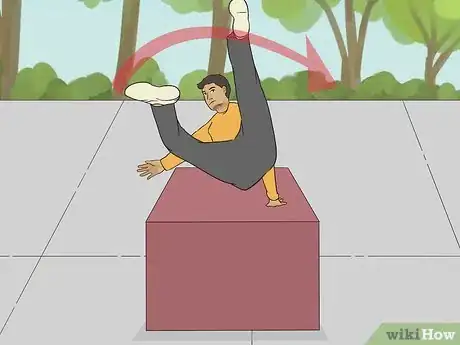

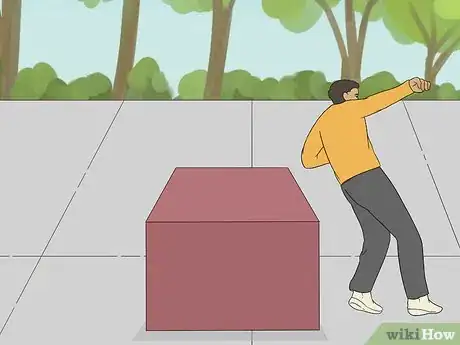

















-Step-8-Version-2.webp)





































